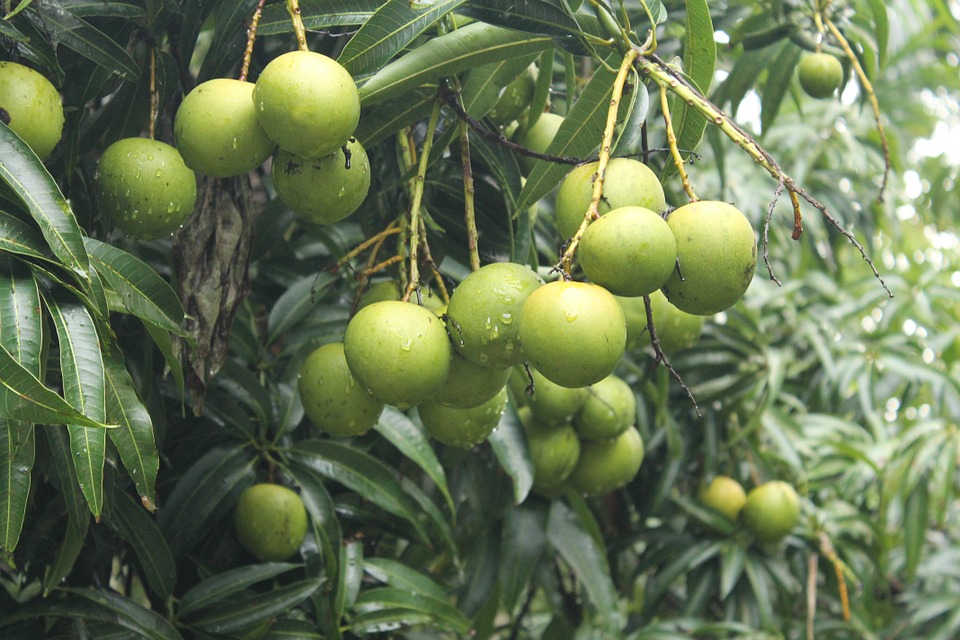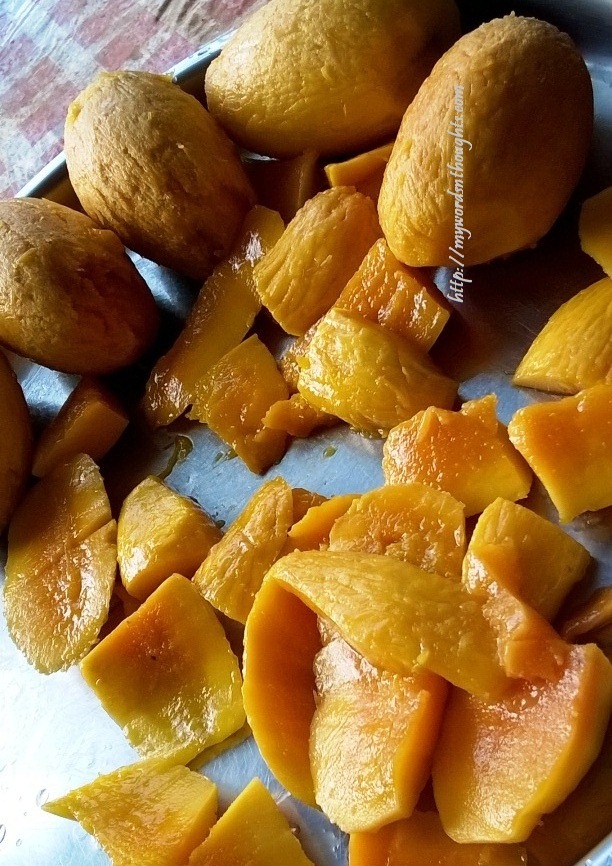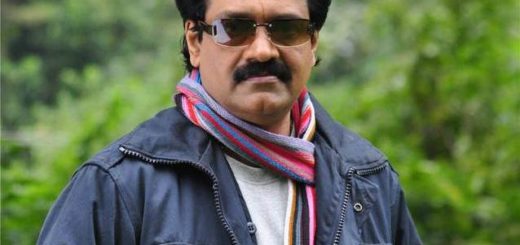100 Varieties of Local Mangoes Available in Kerala
Mango tree – The tree which reserves sweetness in its fruits and shade in its branches. Mango is called ‘Maanga’ in Malayalam, and Mango tree as ‘Maav’. Local varieties called ‘Naattu Maav’ own many specialties in abundance. Their fruits are pesticide-free, sweet without any artificial flavours and trees also provide shade to many living beings. But nowadays such local varieties have already started vanishing and hybrid varieties are in need. Read more to know. Through this column I would like to give a brief note on local varieties of mangoes, known by name ‘Naattu Maanga/ Naattu Maangakal’ in Malayalam language.

1. Chandrakaaran – One of the most common and popular mangoes locally available in Kerala. These small sized bananas are excellent for eating as fruit and for preparing dishes such as Maambazha Pulissery, Kaduku Maanga etc. Its seeds are big. Earlier Chandrakaaran was commonly available in all homes across Kerala, especially old Tharavad (ancestral homes). But now this variety is almost extinct. This variety make branches from bottom, and have mangoes in bunches. It’s a spectacular scene to watch mango branches hanging from trees. Its aroma is very pleasant.
2. Kilichundan – Its tip resembles the beak of birds, and hence known by the name Kilichundan maambazham. Kilichundan means beak of a bird in Malayalam language. It’s used to make pickles and make curries.
3. Moovandan – Yet another common mango of Kerala, Moovandan is deeply linked with Kerala culture too. It takes only three years for its tree to blossom. That’s why this mango variety got this name (‘Moonnu’ means three and ‘Aand’ means year). They grow as branches, and filled with leaves. They show moderate amount of sour, fiber and sweetness in fruits, and can also be used to prepare dishes. They can be used as Kanni Maanga (small types used for pickles and kondattam), green mango to prepare pickles and many vegetarian/non-vegetarian dishes and as fruit. Moovandan grows in any condition and varieties such as blue (neela moovandan), black (karutha moovandan) and white (velutha moovandan) are available.
4. Varikka (Panchasaara Varikka) – Known by both these names, they are small type of mango trees. Seen as bunches, their similarities to sugar earned the name Panchasaara Varikka. They are medium-sized mangoes.
5. Kottukonam – Its real name is Kotturkonam. The most popular variety of south Kerala and is quite similar to Varikka. Very often these names are interchanged and used. The tree has so many branches and bears many mangoes as well. Mango’s skin is thick and is less-sour in taste. It can also be used unripen, but it tastes best as fruit. As it ripens, its taste also increases slowly. Its flesh is in variant colours such as red, orange and yellow, though they taste almost similar. As it has red colour flesh, it’s also known by the name Chenkal varikka. This fruit resists flies and starts bearing fruits at the age of three years.
6. Olor – This mango type is mostly seen in Kozhikode district and is available since the month of February. Mangoes are very sweet. Oval shaped mangoes they are soft, fiber rich and slight aroma.
7. Neelam – One of the most popular varieties, they are big sized and very tasty. Neelam is commonly available in Kerala, and it grows well in this state’s climatic conditions. It can be preserved for long days without damage, and known for its pleasant aroma, taste and stiffness.
8. Priyor – Big, tasty mangoes with pleasant smell and less fiber commonly available in Thrissur. Tips of mangoes are curved and since they are big in size, only less number of mangoes will be seen in each bunch. Some may weigh up to 250 grams. Often compared with the taste of guava, it’s also called Peraykka Maav locally. Apart from seen locally, it’s also cultivated in certain areas for business. Trees give mangoes early comparing other seasonal mangoes. Its leaves are slightly big.
9. Vellari – As this mango has taste similar to cucumber, it’s known by the name Vellari Maanga. They are less-sour and with big seeds, and excellent for making pickles. Fruits are easily attacked by pests and worms, and hence better to use without waiting too much. They start blossoming and bear fruits at a younger age.
10. Paandi – Seen in several places of Kerala, the trees shoot up high. Mangoes are small and own a distinct smell. Its stalk is lengthy and up to 15 mangoes can be seen in a single bunch. When it ripens, the fruit turns yellow in colour.
11. Karpoora Maanga – Abundantly seen in middle Kerala, Karpoora Mango is big sized. It smells and tastes like camphor (Karpooram) and that’s why it got the name Karpoora Maanga.
12. Puliyan – Also called pulichi maanga, depending on the sour taste, there are several local varieties available. Some of them are juicy and tasty once ripened, while a few are mostly used as green mango for curries and pickles. Seeds are big; its leaves too. They grow as branches, and its wood is used as firewood, and for doors and windows.
13. Kappalumaanga – Also known by the name ‘Tholikayyan Maanga’, it’s commonly seen in south Kerala. Big in size and stiff, yet less in fiber, that’s the peculiarity of Kappalumaanga.
14. Kuttiyaattoor – Known by the name of a place of Kannur district, it has one more name, Nambiar Mango (Nambiar Maanga). Once it ripens, its lower part turns yellow. The tree blossoms in the Malayalam month Makaram (January-February) and it widely spreads its branches too.
15. Gomaanga – Its skin colour is dark with a combination of red and black colours. The colour sustains even when the mango ripens. This mango well ripens in the monsoon season, so a bit late comparing other mango varieties. Seeds are big in size, and mangoes are seen as bunches. Mangoes are used as fruit, and also used as green mangoes for curries.
List of 100 Local names of mangoes (100 Naattu Maanga)
Same mango may be known in different names in many regions. Here is the list of 100 such names in which local mangoes (naattu maanga) are known.

- Achaar Maanga
- Attanaari Maanga
- Babbakkai Maanga
- Bappiloose Maanga
- Chakiri Maanga
- Chakkachi
- Chakkara Kuttan
- Chakkara Maanga
- Chakkarakodan
- Chakkarakutty
- Chakoriyan
- Chandana Maanga
- Chandrakkaaran
- Chelan Maanga
- Chena Maanga
- Cherukaattu Maanga
- Cheruvarikka
- Chiri Maanga
- Chola Maanga
- Choppan
- Choriyan Maanga
- Elore Maanga
- Gomaanga
- Jeerake Maanga
- Kaasi Maanga
- Kadaykkalmaanga
- Kadukka Maanga
- Kadukkaachi
- Kalli Papaaya
- Kalluketti
- Kanammaavu
- Kappai Maanga
- Kappamaanga
- Kappi Maanga
- Karutha Moovandan
- Kayappan
- Kili Maanga
- Kilichundan
- Kottamaanga
- Kottukonam
- Kulam Maanga
- Kumadigana
- Kumadigana
- Kundara
- Kunjan Maanga
- Kunjan Maanga
- Kuriyan Maanga
- Kurukkan Maanga
- Kuttiyaattoor Maanga
- Madhurapuliyan Maanga
- Mailaappu
- Moovandan
- Naaranga Maanga
- Naattuneelam
- Nambiar Maanga
- Nanyaar Maanga
- Neduneelan Maanga
- Neelam Maanga
- Neelavarikka
- Neerukudiyan
- Nellikka Maanga
- Nettukuzhiyan
- Ola Maanga
- Oombikudiyan Maanga
- Oru Maanga
- Pachatheeni
- Palliyaadan
- Panchaara Maanga
- Panchaara Varikka
- Panchara Katti
- Parayan Vellari
- Peraykka Maanga
- Plaathi Maanga
- Priyor
- Puli Maanga
- Pulichi Maanga
- Pulippan
- Pulissery Maanga
- Puliyan Maanga
- Sannajeerake Maanga
- Sarkkaraasi
- Sharkkara Maanga
- Sonai Maanga
- Sundari Maanga
- Sundarichi
- Suvarna Maanga
- Thaalimaanga
- Thathachundan
- Thathakothan
- Thenpuliyan Maanga
- Thenthulli Maanga
- Thitheyyan Maanga
- Tholikaippan
- Vatta Maanga
- Vayanaadan Panchara
- Vella Maanga
- Vella Moovandan
- Vellakkaai Maanga
- Vellamkolli Maanga
- Vellarimaanga
Also read: A few thoughts on local mangoes of Kerala
Different varieties of banana available in Kerala.





Error thrown
Call to undefined function create_function()